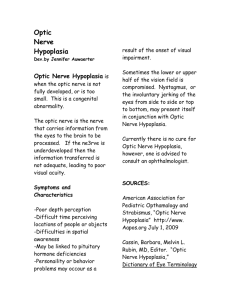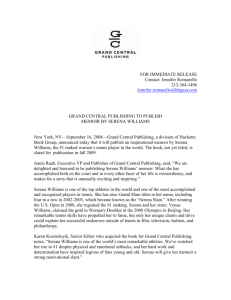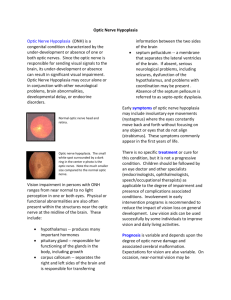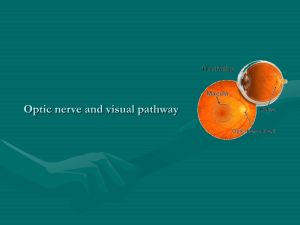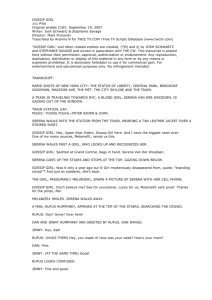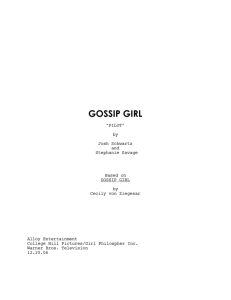Optic Nerve Hypoplasia - Stephen F. Austin State University
advertisement
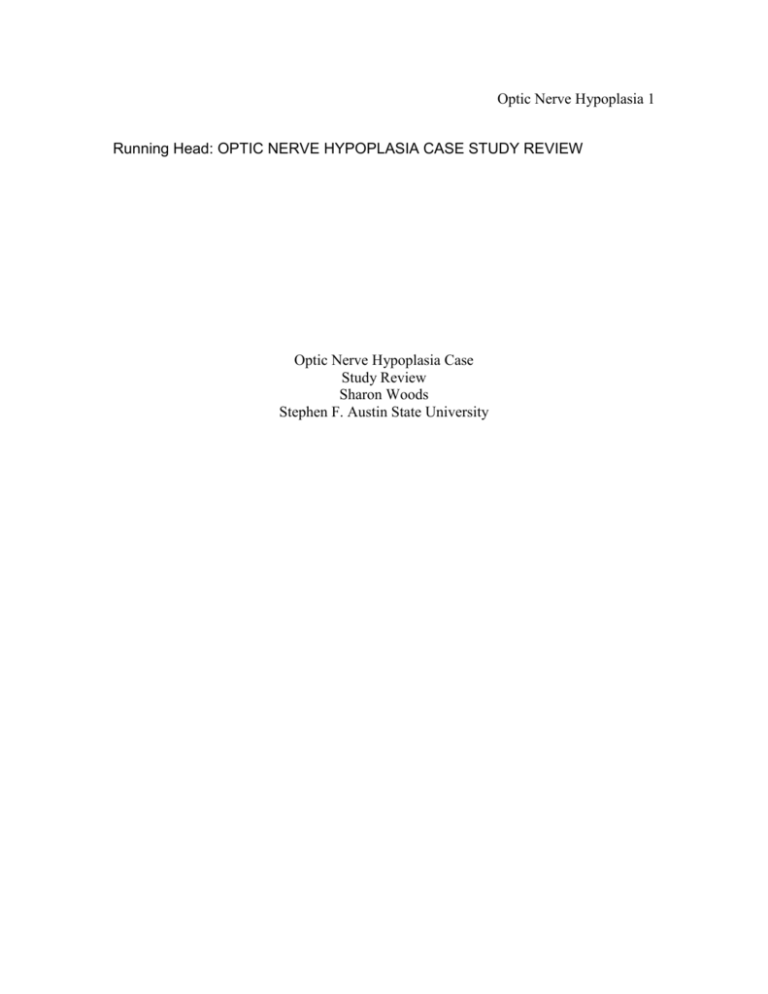
Optic Nerve Hypoplasia 1 Running Head: OPTIC NERVE HYPOPLASIA CASE STUDY REVIEW Optic Nerve Hypoplasia Case Study Review Sharon Woods Stephen F. Austin State University Optic Nerve Hypoplasia 2 Serena is a fifteen-year old young lady who has a visual impairment due to optic nerve hypoplasia. The onset of her visual impairment was congenital. At birth or soon after she was diagnosed with bilateral optic nerve hypoplasia. The medical history report states that she experiences no light perception in her right eye, as well as esotropia oculus dexter (OD). Her distance acuity in her left eye is 10/400 without correction and 10/225 with correction according to an ophthalmologist’s report. These measures can be converted to Snellen measurements of 20/800 and 20/450 respectively. Her near distance acuity measured at two inches without correction is equal to that of a normal acuity at three meters; with correction it is equal to that of normal vision at eight tenths of a meter. Serena’s functional visual fields are limited to five degrees in her left eye nasal and temporal and 15 degrees superior and nasal. Serena is legally blind according to the definition of 20/200 or better in the better eye with correction. She also meets the criteria for legally blind due to her visual field of less than 20 degrees. Although Serena has no vision in her right eye and limited acuity and visual field in her left eye, color perception is functional. A functional vision assessment revealed that Serena has no vision in her right eye. Her left eye’s limited visual field allows her to read print as small as 12 point when it is held within one inch of this eye, on some days. It was determined that the most appropriate print size for Serena is between 18 and 24 point, with high contrast. Good lighting is necessary in order that Serena can use her remaining vision when functioning within and between all her environments. She uses her vision very well to get around in normally lit environments without the aid of a cane, but may benefit from the use of a Optic Nerve Hypoplasia 3 cane to navigate obstacles in dim lighting (stairwells, auditoriums during a performance). Serena will not use her cane on her own initiative; a significant amount of prompting is needed to get her to use the cane. Lighting is not as crucial factor when she uses her functional vision to read, because she must hold the text so close to her eye that her face creates a shadow on the material being read. Serena will benefit from the use of glarereduction devices to decrease irritation by bright lights. NOIR shields or tinted glasses and a visor are some options for her. A significant observation is noted in Serena’s file. She was observed in daylight when she was waiting at the curb for her ride. She did not identify the object in front of her as the car she was waiting for. Her visual field is so limited that the part of the car she saw was not recognizable as being a car. Classroom Based Performance Using both print and Braille for daily living and academic purposes, Serena reads within the level two to level three ranges. She enjoys accessing age appropriate literature though audio taped versions. Her writing skills are at a range between grade one and grade two Braille. Serena uses phonetic or invented spellings. She can use both the Perkins Braillewriter and the Braille‘n Speak. Serena understands the concepts of addition, subtraction, multiplication, and division, but has difficulty when applying these concepts when problem solving. She understands the value of, and uses money in a functional and efficient manner. Optic Nerve Hypoplasia 4 Support in adapting classroom instruction and assignments as well as individual instruction in using and applying assistive technology is a continued need in order that Serena will benefit from instruction in the school’s curriculum for reading, written language, and math. Social/Emotional/Vocational Serena’s social skills and personal knowledge have improved a great deal. She continues to benefit from direct instruction and guidance in appreciating her strengths, and learning to accept and live with her disabilities. Continued instruction and practice in self-advocacy; knowing what she can do for herself and when she needs help from others is needed. Serena has gained appropriate grooming and behaviors for the work force. She has very limited knowledge of her interests as they relate to future jobs. She continues to need direct instruction and experiences in order to acquire a realistic picture of where her place in the work force may be. Continued direct instruction in orientation and mobility, as well as in the areas of social, emotional, and vocational will benefit Serena by improving her ability to move in her environments safely and independently, gaining the ability to find her place in society. Serena’s needs are clearly due to the visual impairment and cannot be fully met without special education and related service support. Serena qualifies as a student with visual impairment under the Montana Administrative Statutes and Rules for Special Education (2001). Optic Nerve Hypoplasia 5 In determining eligibility, the child study team must consider: 1. Classroom Based Performance 2. Observation 3. Parent/student information The student is being identified as having visual impairment using the following criteria: 1. There is documentation that the student has: a. visual acuity of 20/70 or less in the better eye with correction or b. a field of vision which at its widest diameter subtends an angle of no greater than 20 degrees in the better eye with correction. 2. There is documentation that measures of student performance (e.g. achievement test, grades, behavioral assessments, analysis of classroom assignments, or criterionreferenced tests) indicate a pattern of educational attainment that can wholly or in part be attributed to the disabling condition. 3. The student’s needs due to the visual impairment cannot be met without special education and related services. 4. Classroom-Based Performance supports that the student needs special education and related services. Optic Nerve Hypoplasia 6 References Montana Administrative Statutes and Rules for Special Education, 10.16.3001 -3006 and 10.16.3022 (2001). State Board for Educator Certification (2003). Preparation Manual for The Examination for the Certification of Educators in Texas (ExCET) Visually Impaired 36 Braille 75. Retrieved from http://www.excet.nesinc.com/excetstudyguid/ 36% 20 Visually %20Impaired.htm
